by Alessia Leibert
July 2015
Two years after completing their degrees one third of Minnesota college graduates had jobs outside the region where they went to school. Incentives to leave the region of schooling can be very personal, including lifestyle preferences, proximity to family, and commuting distances. The most powerful incentive, however, is the pull of economic opportunity. Graduates are more likely to move to places where hiring in their career field is stronger and jobs are better paid.
Young graduates start settling in a career during the initial years after graduation, tending to gravitate towards places that give them better chances at utilizing their degrees. Therefore, the geography of jobs for graduates two years after finishing school tells a story about local hiring demand and the unique skills profile of regional labor markets.
Data on regions of employment for recent graduates are publicly accessible this year for the first time through the Graduate Employment Outcomes online tool. As shown in Figure 1, the Metro Area took the lion's share - 64 percent - of employed graduates, thanks to its high concentration of schools, businesses, and jobs. In 2014, for example, the Metro Area accounted for 60 percent of jobs and 56.4 percent of job vacancies in the state1.
As shown in Figure 1, the rank-ordering of regions by number of graduates differs slightly from the rank-ordering of regions by number of employed graduates, indicating that some regions experienced a positive balance while others experienced a negative balance. For example, the Twin Cities Metro Area definitely employed more graduates than it produced, 64 percent versus 56 percent, while Southeast Minnesota managed to attract the third highest share of graduates (7.5 percent) despite producing the least (7.2 percent). This means that the Twin Cities and Southeast Minnesota were most successful at both retaining locally trained talent and attracting talent from outside. Every other region experienced negative balances, ranging from 22 percent in Central Minnesota to 37 percent in Southwest Minnesota. Greater Minnesota as a whole lost 36 percent of its graduates to the Twin Cities.
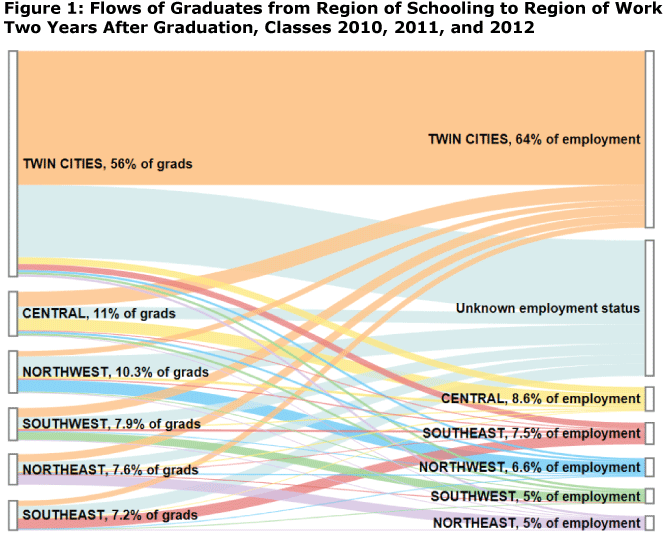
Note: The sources for all data in this article are the Minnesota Department of Employment and Economic Development unemployment insurance wage records and the Minnesota Office of Higher Education post-secondary graduation records.
Regions with long interstate borders, such as the Northwest and the Southwest, were more likely to experience a loss of graduates for two main reasons. First, they attract students resident in neighboring states who are more likely to find a job close to home after graduation. Second, if the economy of the neighboring state is booming, more graduates will be drawn there and not be found in Minnesota Wage Records. The booming oil industry in North Dakota might partially explain why Northwest Minnesota has such a large portion of graduates with "unknown employment status"2.
More detailed information about regions of employment for recent graduates is presented in Figure 2 with the inclusion of graduates' median wages. Wage information adds an important dimension to this analysis because it reveals the financial incentives to move. Wages were highest in the Twin Cities where the cost of living is high and lowest in Northwest Minnesota where the cost of living is the second lowest in the state.
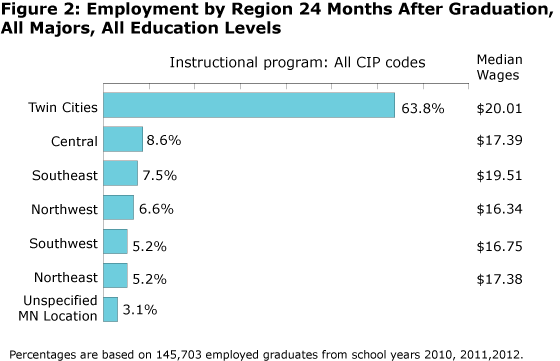
Besides reflecting different cost of living conditions, wage differences also stem from a region's ability to provide jobs that require a high skill level. The Twin Cities and Southeast Minnesota have higher wages not simply because of a high cost of living but because they are most successful at creating jobs that require a four year degree or higher. Figure 3 shows that individuals with graduate level academic credentials are compensated nearly equally across regions, but Northwest Minnesota and Northeast Minnesota attracted the smallest share, 3.6 and 3.5 percent respectively.
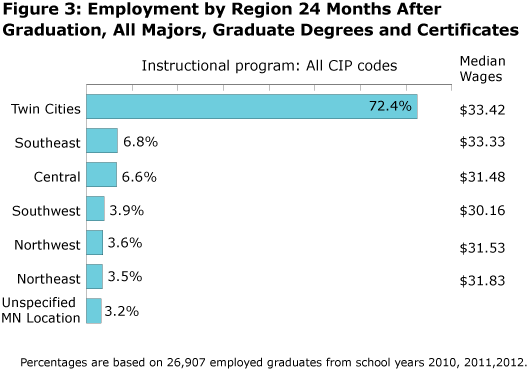
Education level and major are the biggest factors determining where on the map graduates are most likely to cluster in the first two years following graduation. Bachelor's and advanced degree holders are more likely to end up with jobs in the Twin Cities or to leave the state. In contrast, individuals with certificates and associate awards are more likely to stay in Minnesota and find a job in the region of their schooling. This is particularly true for skilled trade majors such as construction, repair and maintenance, and production, because employers prefer to fill these jobs locally rather than recruit from other regions through expensive advertising. Figure 4 looks at graduates in Precision Production who attended school in outstate Minnesota. Only 15.9 percent were lost to the Twin Cities, where wages were higher but apparently not high enough to draw more workers. This is clearly an example of a training program that effectively targets the needs of local employers.
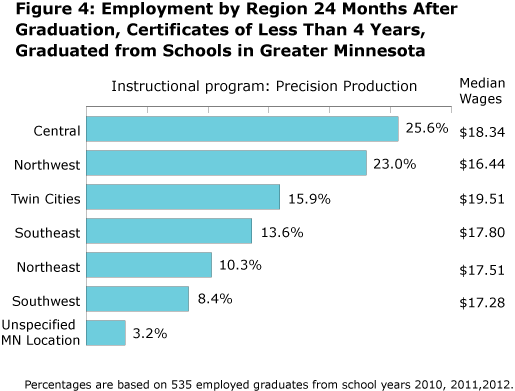
Likewise, individuals trained in Greater Minnesota to become HVAC, Vehicle, or Industrial Equipment Maintenance Technicians tended to stay in the region of schooling. Only 12.5 percent moved to the Metro area (Figure 5). This stands as a proof of the role of technical/vocational schools in supplying talent to local employers, contributing to regional economic growth.
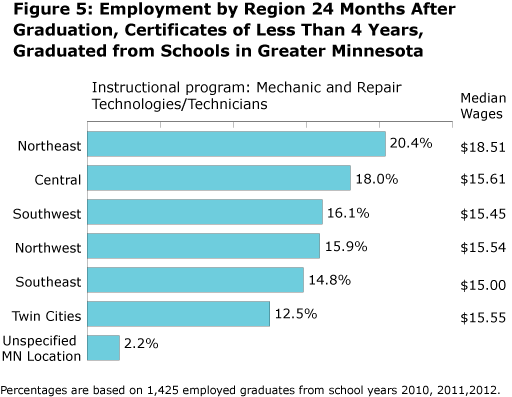
Each region attracts talent in economic sectors that are unique to its economy. Looking at where graduates from certain fields chose to start their career reveals each region's unique competitive advantage in retaining and attracting talent. The map below illustrates each region's workforce skills profile represented by two measures. First, we show which majors had a high concentration of recent graduates employed in the region, indicating stronger demand for skills and academic credentials in these fields of study relative to other regions. Second, we provide examples of local industries that were more likely to hire recent college graduates who majored in these fields. The examples of majors provided are just a representative set not meant to be comprehensive, as each region can have more than one area of high concentration of college graduates' employment.
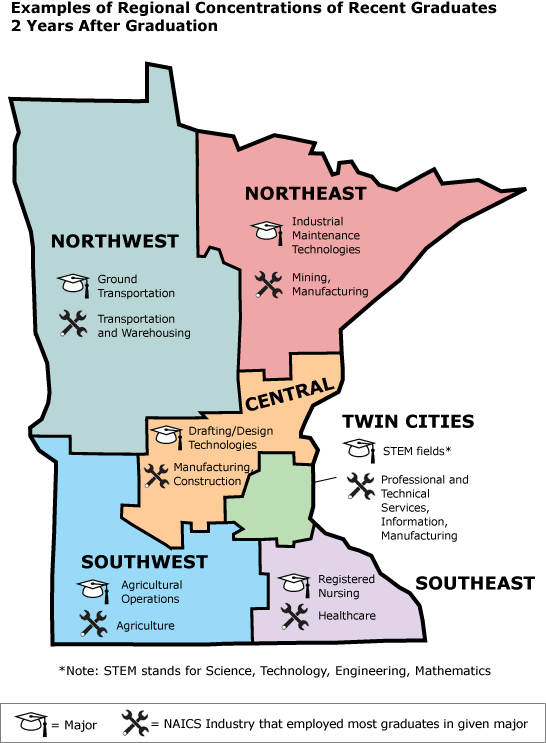
The region is the most popular destination for graduates in STEM (Science, Technology, Engineering, and Math) fields, thanks to the presence of high tech industries and company headquarters where hiring is strong in engineering, finance, business operations, and IT. Not surprisingly, three of four (77 percent) of workers in STEM occupations in 2014 were located in the Metro Area. For example, 82.4 percent of employed computer engineering graduates worked in the Twin Cities, followed by Southeast Minnesota (Figure 6). Job opportunities apparently did not exist in other parts of the state or were not attractive enough for graduates.
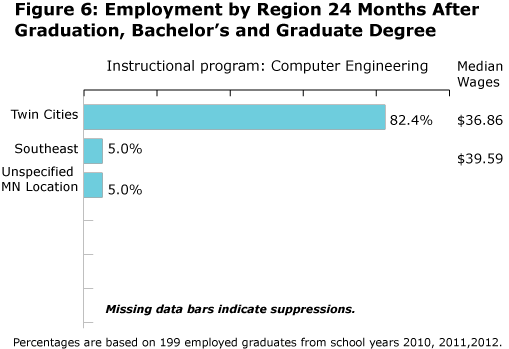
The attraction of this region is tied to high demand for a skilled healthcare workforce and the presence of some high paying employers. The Twin Cities and Southeast Minnesota together absorbed 74.9 percent of recent Bachelor's nursing graduates with median wages of $35.74 and $34.78 respectively (see Figure 7). Median wage rates for individuals with the same degree were seven dollars lower in Southwest Minnesota.
What might be the causes of such large wage differences? Small rural hospitals and nursing homes in outstate Minnesota may not need as many Bachelor's-degreed nurses to begin with, and when they need them, they can't pay the same salaries as their competitors in neighboring regions.
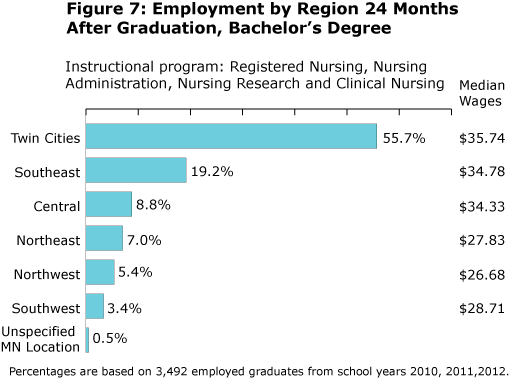
This region is characterized by a thriving manufacturing sector and intense residential construction activity that generates demand for people with skills in architectural and mechanical drafting. This region was the second most popular for graduates in Drafting/Design Technologies in the state, absorbing almost 17 percent of the supply (Figure 8). Some of these graduates were trained locally, and some were attracted from neighboring regions to work in machine shops, furniture manufacturers, construction firms, and many other related industries.
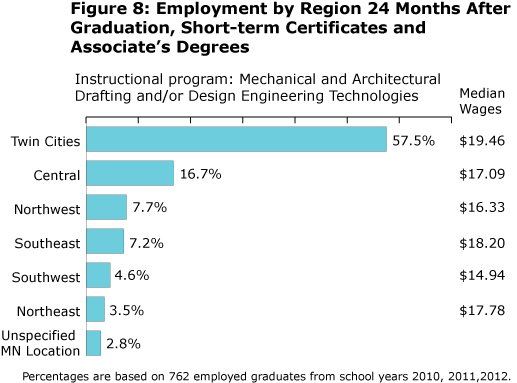
The region's economy is heavily agriculture-driven. Therefore, hiring is very strong and wages are competitive for recent graduates in agricultural-related majors (Figure 9).
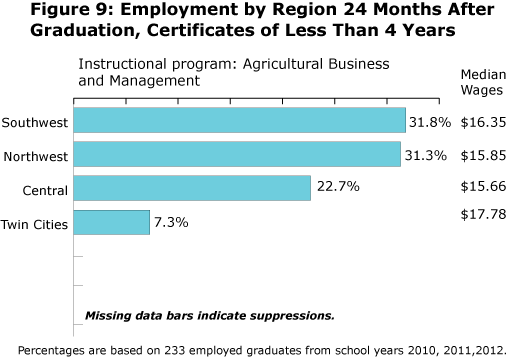
The region hired the majority (24.2 percent) of individuals majoring in Ground Transportation, including truck driving and heavy equipment operations for road construction (Figure 10). Most of these graduates were trained at local schools to work in the region's transportation and warehousing industry. Trucking and road construction skills are in great demand to move agricultural products, especially sugar-beets and potatoes, to the local processing plants and from the plants to wholesalers across the country.
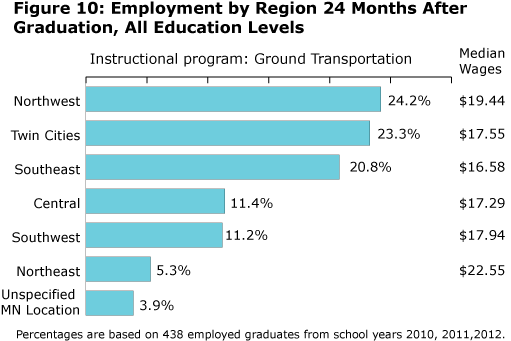
The Arrowhead is the second most popular region of destination, after the Twin Cities, for individuals majoring in Industrial Mechanics and Maintenance Technology (Figure 11). That is primarily because 30 percent of these graduates get hired by the mining industry which is unique to Northeast Minnesota.
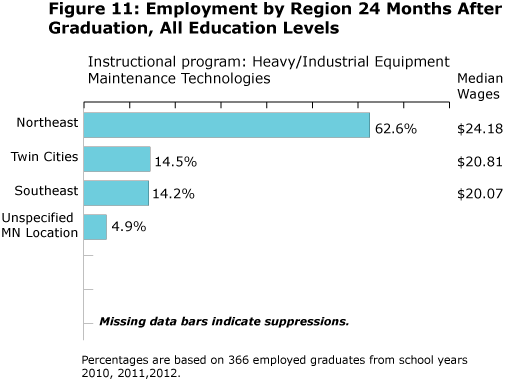
The evidence presented in this article clearly demonstrates the economic incentives for graduates to locate in certain parts of the state depending on their academic field. Graduates are responsive to wage differences for jobs requiring their credentials and take them into consideration when choosing where to start a career.
The geography of jobs for graduates has very important implications for regional economic development. Employers, educators, and economic developers alike have an interest in knowing the skills of available workers in their region to market themselves to potential businesses and to demonstrate the impact of their activity on economic competitiveness.
1MN Occupational Employment Survey (OES) 2014, MN Job Vacancy Surveys 2014
2Unknown employment status, as in Figure 1, indicates that the graduate was not employed in Minnesota after graduation and thus cannot be followed using the Unemployment Insurance wage records for Minnesota.